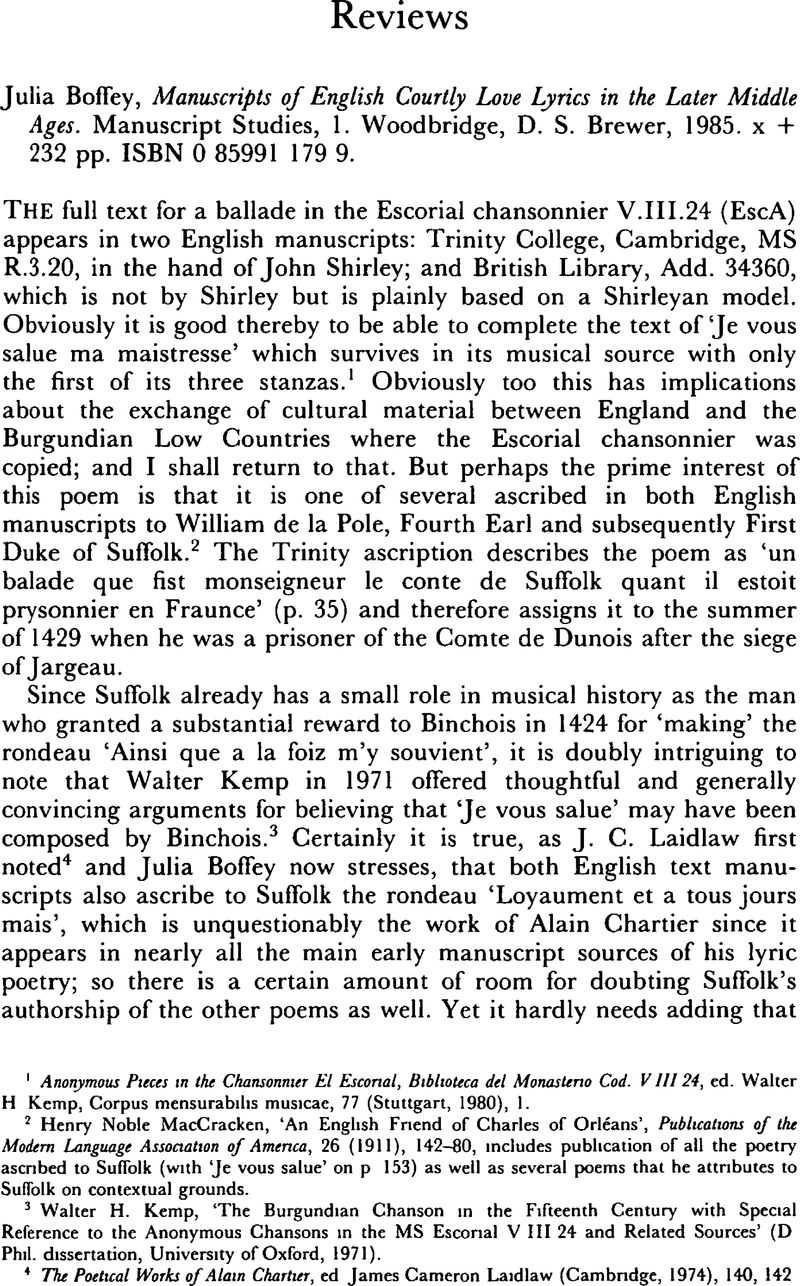No CrossRef data available.
Article contents
Julia Boffey, Manuscripts of English Courtly Love Lyrics in the Later Middle Ages. Manuscript Studies, 1. Woodbridge, D. S. Brewer, 1985. x + 232 pp. ISBN 0 85991 179 9.
Published online by Cambridge University Press: 01 January 2020
Abstract

- Type
- Reviews
- Information
- Copyright
- Copyright © Royal Musical Association, 1987
References
1 Anonymous Pieces in the Chansonnier El Escorial, Biblioteca del Monasterio Cod. V III 24, ed. Walter H Kemp, Corpus mensurabilis musicae, 77 (Stuttgart, 1980), 1.Google Scholar
2 MacCracken, Henry Noble, ‘An English Friend of Charles of Orléans’, Publications of the Modem Language Association of America, 26 (1911), 142–80, includes publication of all the poetry ascribed to Suffolk (with ‘Je vous salue’ on p 153) as well as several poems that he attributes to Suffolk on contextual grounds.Google Scholar
3 Walter H. Kemp, ‘The Burgundian Chanson in the Fifteenth Century with Special Reference to the Anonymous Chansons in the MS Escorial V III 24 and Related Sources’ (D Phil, dissertation, University of Oxford, 1971).Google Scholar
4 The Poetical Works of Alain Chartier, ed James Cameron Laidlaw (Cambridge, 1974), 140, 142Google Scholar
5 In fact private notes kindly lent to me by Professor Frederick Crane of the University of Iowa show that he had previously made the same identificationGoogle Scholar
6 The stanzas have been printed in MacCracken, ‘An English Friend of Charles of Orléans’, 145, and Charles d’Orléans, Poésies, ed Pierre Champion (Paris, 1923–7, repr. 1966), 573Google Scholar
7 Sechs Trienter Codices Geistliche und weltliche Kompositionen des XV Jhs. II Auswahl, ed Guido Adler and Oswald Koller, Denkmaler der Tonkunst in Österreich, 22, Jg 11/1 (Vienna, 1904, repr 1959), 96 While this review was in proof I noticed a sixteenth-century version of the same poem, this time in seven evidently corrupt lines, opening ‘Amy, helas, ma seur, ma seur, dolente suis’ and entitled (misleadingly enough) ‘Aultre chanson nouvelle’ It is published in Brian Jeffery, Chanson Verse of the Early Renaissance, ii (London, 1976), 235, from S'ensuyvent plusieurs belles chansons nouvelles ([?Alain Lotrian] Paris, 1535), no. III, and Jeffery refers to later printings in 1537, 1538 and 1543 This version does not seem to contain any details that would change my proposed reconstruction, but such longevity in the poem surely adds to the fascination of this little song. I am grateful to Dr Jeffery for offering his thoughts on this and suggesting two improvements to my reconstructed textGoogle Scholar
8 The poem is on pp 92–3 of the Trinity manuscript; it also appears in Pans, Bibliothèque nationale, n a fr 6221, f 10 – a French source that has several more poems in common with the Trinity manuscriptGoogle Scholar
9 Fallows, David, ‘English Song Repertories of the Mid-fifteenth Century’, Proceedings of the Royal Musical Association, 103 (1976–7), 61–79 (pp. 70–4).Google Scholar
10 The source is described, with a fragmentary incipit for the Grenon piece, in Gilbert Reaney, Manuscripts of Polyphonic Music (c 1320–1400), Répertoire international des sources musicales, B/IV/2 (Munich and Duisburg, 1969), 211–12Google Scholar




